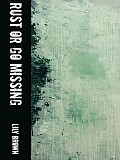|

Lily Brown
Rust or Go Missing
Cleveland State University Poetry Center
2010
$15.95
Lily Brown’s first book, Rust or Go Missing, interrogates the problematic relationship between what we term the natural and the artificial. The "natural," be it a state of being or a pastoral ideal, can never be accessed purely or directly, but only through culturally determined modes of interpretation. Thus, Duke Senior in As You Like It cannot praise nature without invoking civilization, finding "books in the running brooks, / sermons in stones" and Wallace Steven's "Anecdote of the Jar" shows us how a manmade object is the lens through which we view the natural world. Similarly, Lily Brown presents the natural world as either viewed through a human lens or viewed as human. The latter effect is accomplished by personifying elements of the landscape, such as “In January the hills/unbutton their pants,” and “hill with cleft-chin.” In moments like these, Brown brings into question how we see the world and how our seeing changes it, a concern she raises repeatedly in lines such as, “I work to my eye” and “To mold, with one’s hands,/the cliff fog, I use my eye.” Often, the personification is humorous and effective, but at times skirts the line of preciousness, and occasionally I wanted the landscape to just stay still. Brown seems aware of this danger, and some lines seem designed to excuse or justify the personification, such as, “The imagination asked for all the cities, / for the canopy to get its machines out / and tile the leaves.”
More satisfying are Brown’s poems showing the natural world as passively experienced via human construction or technology. In the poem “Sitting in the Car,” Brown beautifully captures the experience of observing the natural world while traveling by car, in which “Sideways, we are/bodies; one dimension, / being moved.” The speaker watches the “Deer-faced cows / in the open range,” a line that overlays wildness on the domesticated, deer on the cows, open on the range, so that the wild and the tamed are inextricably conflated. In this poem, the natural world coexists with human technology but is possibly damaged by it. We watch “Swallows fall from / wire” and then later “the black bird tucks her wings. Swallows / all from wire.”
Birds return, as do other repeated images: windows, the ocean, staircases, books, cars, dogs, hills, and sheets, among others. Often, this repeated imagery serves to create a sense of conversation between poems, an effect further amplified by the book’s thoughtful ordering. For instance, “Its Character” ends with “…the tree line sticks the clouds” and the following poem, “Smaller Gulls Before,” begins with “I want the tree a mile up to shake.” Much of the imagery, such as windows, television screens, and hills, reinforces Brown’s concerns about how we view the natural world. Occasionally, however, the repeated imagery remains a kind of private language of meaning. “Sheets” for instance, recurs in several poems, and it is unclear whether the imagery means anything beyond the immediate associations of carnality. The effect of this can be disappointing and exclusionary, such as when reading, “In the Shins,” a lovely poem that accomplishes many of Brown’s aims effortlessly, but ends with, “Sheets nudge and crease and burn. / Sheets aren’t places. Sheets aren’t / family or places.” As last lines, they bear a lot of pressure, and it’s difficult to know what to do with them in the context of the rest of the poem, which begins with the beautiful stanza:
Nothing means like a poem means
to court me, like a poem means
like burnt wood to flake off.
This kind of fierce enjambment is not unusual for Brown, and she typically uses it to accentuate her wordplay. In the opening poem, “Backpedaling for Statements,“ Brown builds the world that the book explores, one where “window cases mini-landscape.” The window frames the landscape, and window, again personified, sizes up the landscape. The world Brown builds starts out simple, a mere “impression / of groundcover and tree with sunlight” but is then complicated by requests for more information: “She wants to know the climate / of the room where I last wrote.” The speaker, attempting to satisfy this interrogator, adds more and more detail, until the woods suddenly contain a golf course, the golf course contains a “fake fountain,” and finally “Oh god, in the restaurant we overhang / the ocean, overhand the ocean, underlie / erosion.” The commercial dangles over the real, and music enters, people enter, and finally, feeling enters, a sort of panic: “Oh god, / you’ve confirmed the voices, the moonlight.”
It’s moments like these, when some emotion or hint of relationship sneaks in, that the poems are most successful, such as in “Knower,” where “First I was alone, /waiting. Then I was alone/alone.” These simple lines convey a real sadness, and the speaker becomes more concrete and less diffuse than in other poems. While Brown’s concerns are more cerebral on the whole, it’s these moments of warmth that change the landscape of the book itself.
--Rebecca Hazelton
Rebecca Hazelton is the Jay C. and Ruth Hall Poetry Fellow at the Creative Writing Institute University of Wisconsin-Madison. Her work is forthcoming in The Southern Review and The Gettysburg Review, and has appeared in webConjunctions, Pleiades, and Field.
|
|

